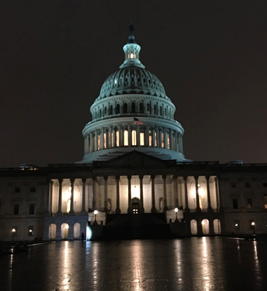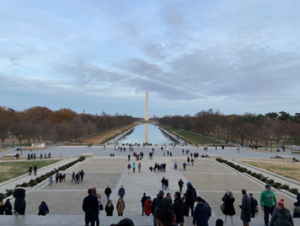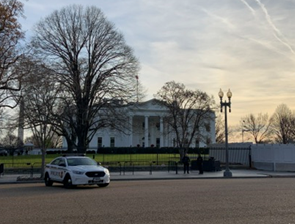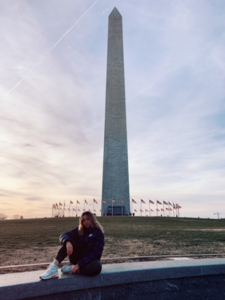by Dounia Mettri.

Dounia Mettri, Medizinische Universität Wien, Österreich
Why America?
This is probably the easiest question for me to answer. Ever since I started medical school, I knew I wanted to go to America. I’ve always dreamed big and America is THE country if you have big dreams and goals. It’s the country where dreams come true, right? Or at least that’s what they say. You can be anywhere you want if you work hard enough and have some luck on top – in theory. And this thrill is what I love about this country. Additionally, America is the most diverse country in the world. You’ll find every single nationality here. How exciting is this?! Those are only some of the reasons why this country is so appealing to me.
To be honest, I had very high expectations before I came to America, since you read and hear everywhere that America is the leading country and has world-class education. What is more, Georgetown University Hospital has a very good reputation and is known to be an “unofficial” ivy league. So, I wanted to make sure this is all based on true facts. Spoiler alert. It definitely is!
Application

© Dounia Mettri, Washington DC Capitol
The application process I went through is slightly complicated. I attended a Radiology Conference in Copenhagen in 2017 (CIRSE) where I met an Interventional Radiologist from California. After having had a long chat with him and after me expressing my fascination about America, he just asked me if I wanted to do an elective at the hospital he was working at. He gave me his contacts and told me to message him. Unfortunately, in America it all comes down to the hospital regulations. And the hospital regulations at the hospital he was working at wouldn’t allow me to come. So, he had put me in contact with a colleague of his, who works at Georgetown University Hospital (GUH). This colleague of his just asked me if I wanted to come to GUH and obviously I said yes. Of course, I said yes! So, in this case it was rather luck plus meeting the right person at the right time.
Tasks
As a medical student rotating in Radiology, my main task in Diagnostic Radiology was to observe and shadow the attendings. Very soon, however, I was allowed to interpret CTs and MRIs myself and dictate the findings. Afterwards a resident would usually discuss the findings with me and make alterations or rephrase my sentences if needed, before an attending would double check and eventually edit our report to ultimately sign it off.
In Interventional Radiology my task was “slightly” different. I observed common interventional procedures, such as mediport-, central line-, internal-external biliary drain- (IEBD) and G tube placement, uterine artery embolization, mediport removal, CT guided liver/kidney/lymph node biopsy or US-guided paracentesis. I would scrub in as well, however, due to strict hospital regulations I wasn’t allowed to touch a patient. Patients that had undergone procedures like central line- or IEBD placement had to stay as inpatients for observation. My task for the following morning at 6am was to check up on those inpatients, view their labs and vitals and make sure no acute events had happened overnight. Every student would get up to 3 patients assigned for that morning. Afterwards we, the fellows, residents and medical students (if there were any other students beside me) would head off at 6:30am to quickly see those patients (like a “Visite”). This is what they call “pre-rounding”. At 7.30am, at “Grand Rounds”, all the medical students would present the inpatients to the attendings.

© Dounia Mettri, View from the National Mall
Hierarchy
The hierarchy in American hospitals is slightly different than the hierarchy in Austrian ones. You have interns, which are medical graduates in their first year of training. This intern year has to be completed in Internal Medicine or Surgery. In Radiology this intern year is referred to as “preliminary” year because it’s not possible for Radiologist-to-be to start with their Radiology residency right away. The pathway of a Radiologist in America is the following. 1 year of intern year (Internal Medicine or Surgery), 4 years of residency (Diagnostic Radiology) and then 1-2 years of fellowship (depending on what specialty). 1 year for most Diagnostic Radiology specialty and Interventional Radiology. Neurointerventional Radiology, however is 2 years of fellowship. After completion of your fellowship, you become an attending (= Oberarzt). So, in total it’s 6-7 years of additional training after graduation to become a Radiologist in the United States.
Language

© Dounia Mettri, The White House
The different language wasn’t a barrier at all. It was easy to follow discussions; however, I had already spent 3 months at Pennsylvania Hospital in Philadelphia right before I got to DC and also a semester in London a year ago, which made it easier for me. But even if you didn’t understand something, everyone is so welcoming towards Europeans, they would happily explain it again or talk more slowly if needed. Nevertheless, I highly advise everyone to have a look at all the English medical terms if you’re not familiar with them. Some of them are completely different and some of them are in a different order (f.e Arteria femoralis communis = Common femoral artery). On top of that, Americans use tons of abbreviations (f.e. CFA = common femoral artery, SBS = Short bowel syndrome, FAS = fetal alcohol syndrome, GBS = Guillan-Barre-Syndrom etc.). This is something that might take a while to get used to as an international student, but it obviously makes work easier, especially in a multicultural country like America. So, to make the most out of your elective, I would recommend learning them in advance, otherwise it’s hard to follow when the residents and attendings discuss patients at Grand Rounds in the morning.
Schedule
My schedule varied, depending on which section of Radiology I was currently in. In Diagnostic Radiology I started Monday through Friday at 9am and finished at 4-5pm. In Interventional Radiology I started Monday through Friday at 6am and finished at 6pm. The IR, however was very unpredictable. Depending on how many procedures were scheduled for that day, I sometimes only had to stay till 5pm and sometimes until 8/9pm. There was a noon lecture everyday for all the residents and the medical students rotating in Radiology, which I was allowed to attend. I truly loved those lectures. They were beyond educational plus they served free lunch once in a while, which made them even more appealing for an Austrian medical student that was running out of money in the end 😉

© Dounia Mettri, Washington Monument
Workstation
I couldn’t complain about my workstation at all. Georgetown University Hospital is one of the national capital area’s oldest academic teaching hospitals that owns 609 beds, has over 4,000 personnel. It is located in Georgetown, one of the cutest neighborhoods in DC I’ve seen so far. Georgetown is considered a historic district, to such an extent that the citizens refuse to connect this neighborhood to the public transportation system. There is only a bus that will take you there, no train, metro or whatsoever. This is the reason why it took me 1h to get there every morning and 1,5h to get home due to massive traffic at rush hour, which is basically from 5-8.30pm.
Insurance
Unfortunately, our Austrian insurance is not valid in America. I had to acquire an additional private insurance for 100 Euros that covers medical or hospital related injuries or incidences only. Since I went to America in the belief that I will not get sick or whatsoever because I was sure I had the best immune system, I didn’t waste too many thoughts on additional insurance. To be honest, I didn’t even know my Austrian one (SVA) doesn’t cover anything in America. I had to find out the hard way, when I acquired a UTI and needed to see a General Practitioner for a prescription and ended up paying 120$ just for the consultation. It is safe to say that it is wise to get yourself all set up regarding your insurance.
Living in Washington D.C
Heads up, D.C is a painful expensive city. I lived in an Airbnb, where I had to share one tiny room with 3 other people. We had two bunk beds placed in this room, for which I paid over 1,000$ a month – and it was the cheapest!! Georgetown, since it’s so historical, is even more expensive. The cheapest deal I could find there was 2,500$ a month for a tiny room. If you live in DC the majority of your salary will go into rent, this is one thing you need to be aware of. That’s why almost exclusively everyone who works in DC doesn’t live here. There is a big commute coming from everywhere, making DC even more diverse. To my big surprise, grocery shopping turned out to be as cheap/expensive as in Austria. So, it’s mainly paying the rent that deeply hurts.
Costs
| Flight | 600-900$ |
| Accommodation | at least 1200$ per month (for a teeny tiny room) |
| Cost of living without rent | at least 1100$ per month; in terms of food, this assumes that you get most of your food from the grocery store and prepare them yourself |
| Total for 3 months | 7500-7800$ |
|---|
Interesting Websites
- 25 Things To Do in Washington: https://travel.usnews.com/Washington_DC/Things_To_Do/
- Things To Do in Washington: https://washington.org/things-do-washington-dc
- Dining Guide: https://dc.eater.com/2017/10/24/16072140/best-food-dc-restaurants-where-to-eat

Citation:
Mettri, Dounia: 3 Month Elective in Radiology at Georgetown University Hospital (In: Polak, G. [ed.]: GI-Mail 03, ISSN: 2312-0827 Going International, Vienna 2020)
Here you can download this publication.
Published in GI-Mail 03/2020 (English edition) & 10/2020 (German edition)
- Do you already know our monthly newsletter GI-Mail with useful tips on postgraduate courses?
Sign up here. - Are you looking for vacancies or new career challenges? Here you will find the latest vacancies and job offers.
- Are you interested in up to date postgraduate courses and CME? In our education database »medicine & health« you will find new education events from over 2300 organizers.
